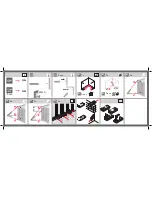
If you can no longer trace the path, even with the GAIN set to maximum, connect the T
RANSMITTER
to the
far end of the path and trace back to the point where you lost the signal.
Mark the straight sections of the path every few feet. Mark sharp curves, loops, and cable bundles every
few inches. Sharp changes in the path cause the R
ECEIVER
PEAK and NULL indications to behave differ-
ently than when tracing a straight path. Practice on the path that you know has turns and laterals in it. This
will help you to recognize the conditions within the field.
Trace the path by walking away from the T
RANSMITTER
at a moderate pace. Move the R
ECEIVER
to the left
and right while walking, following the PEAK indications.
As you trace the path, the PEAK meter reading may slowly fade as you move away from the T
RANSMITTER
.
Press and release the GAIN buttons as needed to compensate for changes in level (higher or lower). One
of the following may occur:
a) a junction where the signal divides and goes several directions.
b) a break in the cable or shield.
c) a change in the depth of the cable or pipe.
d) an insulated pipe fitting.
e) a slack loop of cable.
Peak Mode Locating
Continued
Move the R
ECEIVER
left to right across the cable path. When the R
ECEIVER
is directly above the cable or
pipe, a NULL (lowest meter reading and lowest audio tone) will occur. When moving the R
ECEIVER
to left or
right of the NULL point, the meter reading will rise to a maximum point (PEAK). The audio tone will also be
at
its
highest pitch. When the R
ECEIVER
is moved beyond the PEAK, the meter reading will begin to fade.
Trace the path by walking away from the T
RANSMITTER
at a moderate pace. Move the R
ECEIVER
to the left
and right when walking, following the NULL indications.
As you trace the path, the PEAK meter reading may slowly fade as you move away from the T
RANSMITTER
.
Press and release the GAIN buttons as needed to compensate for changes in signal level. If the PEAK
meter readings suddenly changes in level (higher or lower), one of the following may have occurred:
a) a junction where the signal divides and goes several directions.
b) a break in the cable or shield.
c) a change in the depth of the cable or pipe.
d) an insulated pipe fitting.
e) a slack loop of cable.
If you can no longer trace the path, even with the GAIN control set to maximum, connect the T
RANSMITTER
to the far end of the path, and begin tracing the path back.
Null Mode Locating
Mark the straight section of the path every few feet. Mark sharp curves, loops, and cable bundles every few
inches. Sharp changes in the path causes the R
ECEIVER
PEAK and NULL indicators to behave differently
than when tracing a straight path. Practice on the path that you know has turns and laterals in it. This will
help in recognizing the conditions within the field.
11










































